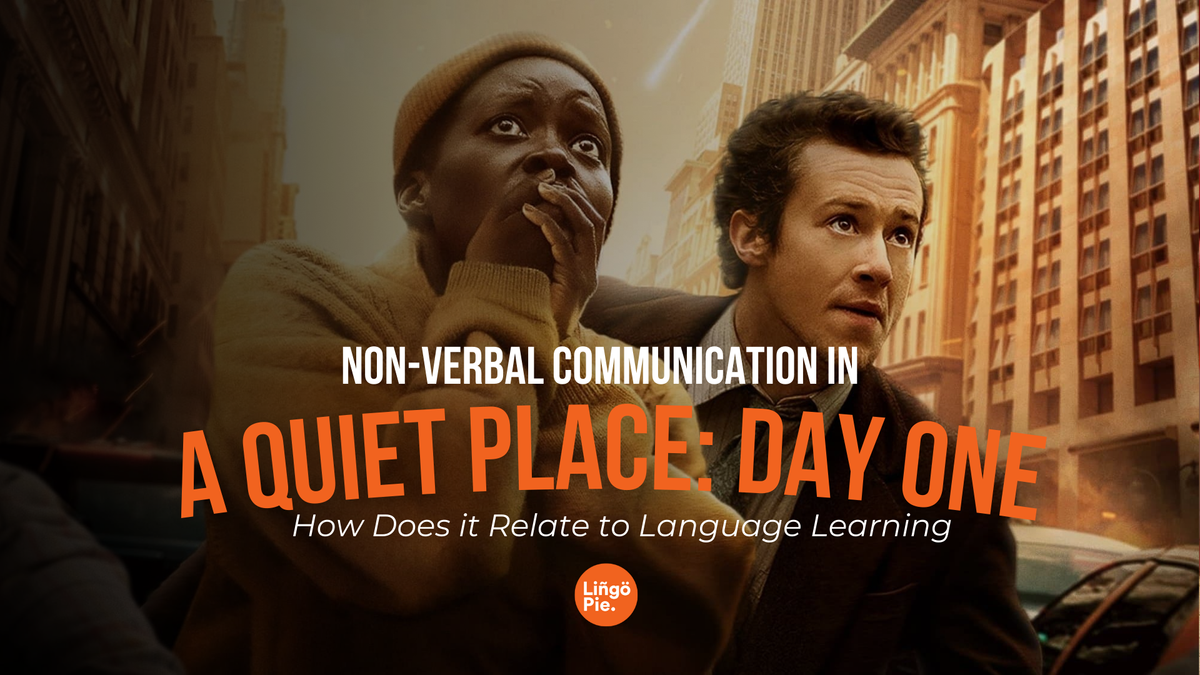In the suspenseful world of "A Quiet Place: Day One," silence is more than just golden—it's essential for survival. Similarly, in the realm of language learning, words are only part of the story. Body language, facial expressions, and intentional gestures accompanying speech all play crucial roles in effective communication. Non-verbal communication, often overlooked, is a fundamental aspect of mastering a new language.
Table of Contents
- Brief Synopsis Of "A Quiet Place: Day One"
- Importance Of Silence And Non-verbal Cues In The Movie's Narrative
- What is Non-verbal Communication?
- The Role Of Non-verbal Communication In Language Learning
- Challenges And Limitations Of Non-verbal Communication
6. Practical Tips for Incorporating Non-verbal Communication In Language Learning
7. Frequently Asked Questions About Non-verbal Communication
8. Conclusion
The film shows how the characters navigate their dangerous environment, relying heavily on non-verbal communication. They use body language, facial expressions, and gestures to convey important messages without uttering a word. In this article, we'll explore the importance of non-verbal communication and how it can improve comprehension, retention, and cultural awareness.
Brief Synopsis Of "A Quiet Place: Day One"
"A Quiet Place: Day One" follows Samira (Lupita Nyong'o), a young woman battling advanced-stage cancer. Encouraged by Reuben (Alex Wolff), her nurse at a suburban clinic, she reluctantly agrees to visit Manhattan to see a show, with the promise of pizza afterward. The outing is abruptly interrupted by the sounds of explosives, signaling the beginning of an alien invasion.
Despite being blind, these creatures have incredibly acute hearing and speed, and they begin hunting any living creature that makes a sound. In the ensuing chaos, Samira teams up with Eric (Joseph Quinn), a British law student, as they struggle to survive amidst relentless attacks from the merciless aliens.

Importance Of Silence And Non-verbal Cues In The Movie's Narrative
In the film, silence is a fundamental survival mechanism. The movie's narrative emphasizes how the characters must communicate and navigate their environment using nonverbal cues to avoid detection by hypersensitive aliens. The absence of spoken dialogue heightens the suspense and underscores the primitive nature of their struggle. Through nonverbal communication, the characters are able to plan, warn, and support each other silently, thus increasing their chances of survival in a world in which every sound threatens them.
What is Non-verbal Communication?
When we talk about non-verbal communication, we refer to the process of conveying a message without using words. It includes a wide range of behaviors, expressions, and signals that communicate meaning and emotions. Unlike verbal communication, which relies on spoken or written language, non-verbal communication often transcends linguistic barriers, making it a universal form of interaction.
5 Types of Non-verbal Communication
- Body Language: This includes movements, posture, and physical orientation. How we move and position our bodies can communicate our feelings, attitudes, and intentions.
- Facial Expressions: The human face is incredibly expressive and can communicate many emotions, such as happiness, sadness, anger, and surprise.
- Gestures: Movements of the hands, arms, or other parts of the body that express ideas or convey messages.
- Posture: This refers to how we hold our bodies. A straight posture can indicate confidence and openness, while a slouched or closed posture may suggest insecurity or discomfort.
- Eye contact: A powerful tool for communication. Maintaining eye contact can indicate attentiveness, honesty, and interest while avoiding eye contact can suggest discomfort, dishonesty, or disinterest.

The Role Of Non-verbal Communication In Language Learning
When we think about language learning, verbal communication naturally comes to our mind. However, nonverbal communication also plays a significant role in enhancing communication and language proficiency. It improves comprehension and overall language skills by adding layers of meaning that help learners comprehend. For instance, gestures and facial expressions help us contextualize spoken words, making them easier to understand and remember.
Nonverbal cues provide essential context in languages where intonation and expression are crucial. A slight change in facial expression or tone of voice can completely alter a sentence's meaning, highlighting subtleties that verbal communication alone may miss. This aspect is especially valuable in languages with intricate grammatical structures or idiomatic expressions defying literal translation.
Furthermore, nonverbal communication supports vocabulary acquisition. Observing native speakers' gestures, body language, and facial expressions in conversations allows learners to gain insights into word usage and cultural nuances.
Challenges And Limitations Of Non-verbal Communication
While nonverbal communication offers numerous benefits, it also presents significant challenges that learners must navigate, particularly in multicultural and virtual learning settings. Cultural differences in nonverbal cues are one of them. A gesture indicating agreement in one culture might signify disagreement or confusion in another. These misunderstandings can interfere with effective communication and hinder language learning progress. To address this, learners should prioritize cultural sensitivity and seek guidance from instructors or resources that go deeper into cultural nuances.
Virtual or online language learning environments introduce further complexities to nonverbal communication. The lack of physical presence reduces the ability to accurately observe and interpret gestures, facial expressions, and body language. Consequently, learners may miss essential contextual clues for comprehension and language acquisition. Educators can counteract this by using videoconferencing tools that facilitate clearer visual interaction. Additionally, integrating multimedia resources depicting nonverbal communication across various cultural contexts can enhance understanding despite the virtual barriers.

Practical Tips for Incorporating Non-verbal Communication In Language Learning
As we explore the benefits and challenges of nonverbal communication, below, we will share some practical tips for language learners to incorporate nonverbal communication effectively into their learning routine.
Observe Native Speakers: Pay close attention to how native speakers use gestures, facial expressions, and body language during conversations. Take note of these cues and mimic them in your own conversations.
Practice in Front of a Mirror: Practice speaking in the target language while observing your own nonverbal cues in a mirror. This will help you become more aware of your gestures, expressions, and posture.
Seek Cultural Understanding: Research and learn about the cultural norms and non-verbal cues of the language you are learning. Understanding the cultural context will help you interpret and use non-verbal cues appropriately.
Use Non-verbal Cues to Reinforce Verbal Communication: During the conversation, use non-verbal cues to emphasize points, communicate emotions, and maintain engagement.
Receive Feedback: Ask native speakers or language instructors for feedback on your non-verbal communication. Their insights can help you refine and improve your body language, gestures, and expressions.
Frequently Asked Questions About Non-verbal Communication
1. How Does Non-verbal Communication Vary Across Cultures?
Non-verbal communication can vary significantly across cultures. Gestures, facial expressions, and body language that are acceptable in one culture may be interpreted differently in another. Understanding these cultural differences is crucial to avoid misunderstandings and to communicate effectively.
2. Can Non-verbal Communication Be Taught?
Yes, non-verbal communication can be taught and learned. Educators can model effective non-verbal communication, use visual aids, and create interactive activities. Learners can observe native speakers, practice in front of a mirror, and seek feedback to improve their non-verbal communication skills.
3. What Are The Main Functions Of Nonverbal Communication?
Nonverbal communication plays a significant role in interpersonal interactions. It complements spoken words by adding context and reinforcing the message through gestures, facial expressions, and body language. It also regulates interactions by managing the flow of conversation, indicating when it is appropriate to speak or listen.
Nonverbal cues can substitute for verbal messages, such as nodding to signify agreement or shaking one's head to indicate disagreement. Nonverbal communication helps establish and maintain relationships by building rapport and demonstrating empathy and attentiveness, among other things.
4. How Effective Is Non-verbal Communication?
Non-verbal communication is highly effective and conveys a lot more than just words. It adds emotional context and subtleties that words might miss. Gestures, facial expressions, eye contact, posture, and tone of voice can communicate feelings and attitudes, often making interactions more authentic and relatable.
Non-verbal cues can also regulate conversations, show interest, and provide feedback, creating a more engaging and interactive communication experience. Sometimes, it can even replace words entirely, communicating clear messages through actions alone.
Conclusion
It is indisputable that non-verbal communication is an essential component of an effective language-learning process. It complements spoken words by adding context and emotional depth and can often replace spoken words, fostering empathy and attentiveness. Understanding and mastering these non-verbal cues can significantly improve a learner's ability to comprehend and use a new language.
The film "A Quiet Place: Day One" is a unique case study on the importance of nonverbal communication. In a world where silence is essential for survival, the characters rely heavily on gestures, facial expressions, and other nonverbal cues to convey emotions and complex messages. This underscores how powerful nonverbal communication can be, even in extreme circumstances.
Movies and TV shows are extremely powerful tools for understanding the proper use of non-verbal communication in the language we want to master. Platforms like Lingopie help us harness the power of media by providing the necessary tools to turn our favorite movie or TV show into an effective and efficient learning resource. By watching native speakers in authentic contexts, we can observe and imitate gestures, facial expressions, and other non-verbal cues, improving our overall language skills.





